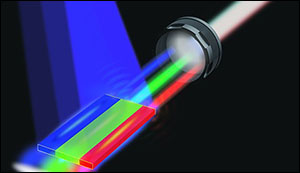ASU engineers demonstrate the world’s first white lasers
29. 7. 2015 | ASU | fullcircle.asu.edu
More luminous and energy efficient than LEDs, white lasers look to be the future in lighting and Li-Fi, or light-based wireless communication.
While lasers were invented in 1960 and are commonly used in many applications, one characteristic of the technology has proven unattainable. No one has been able to create a laser that beams white light. Researchers at Arizona State University have solved the puzzle. They have proven that semiconductor lasers are capable of emitting over the full visible color spectrum, which is necessary to produce a white laser.

The researchers have created a novel nanosheet - a thin layer of semiconductor that measures roughly one-fifth of the thickness of human hair in size with a thickness that is roughly one-thousandth of the thickness of human hair - with three parallel segments, each supporting laser action in one of three elementary colors. The device is capable of lasing in any visible color, completely tunable from red, green to blue, or any color in between. When the total field is collected, a white color emerges.
The technological advance puts lasers one step closer to being a mainstream light source and potential replacement or alternative to light emitting diodes (LEDs). Lasers are brighter, more energy efficient and can potentially provide more accurate and vivid colors for displays like computer screens and televisions. Engineers have already shown that their structures could cover as much as 70 percent more colors than the current display industry standard.
Read more at ASU
Image Credit: ASU
-jk-




